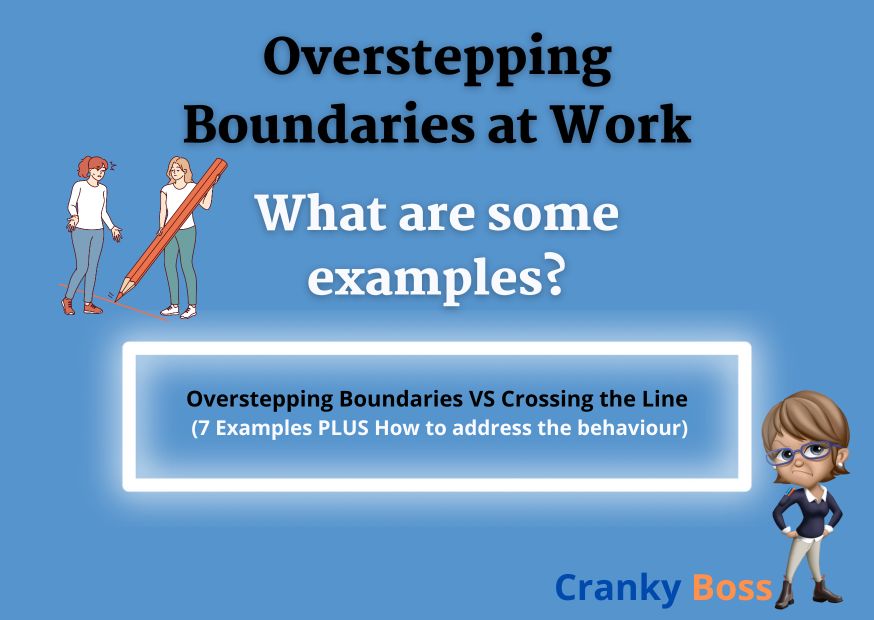Boundaries are important in any workplace. They define the limits of acceptable behaviour and help maintain a respectful and professional environment. However, sometimes people can overstep boundaries in the workplace, leading to discomfort, conflicts, office politics and negative consequences. Let’s look at some examples of overstepping boundaries at work and discuss how to address and prevent such situations.
What is an example of someone overstepping boundaries in the workplace?

Here are a few examples of how someone can overstep their boundaries in the workplace:
1. Personal Space
One common example of overstepping boundaries at work is invading someone’s personal space without permission. This could include standing too close, touching someone without their consent, or constantly peeking over their shoulder while they work. Personal space is a fundamental boundary that everyone deserves to have respected in the workplace.
2. Breach of Confidentiality
Another example is sharing confidential information without authorization. Whether it’s discussing sensitive client data, disclosing private conversations, engaging in malicious gossip or spreading rumours and lies about coworkers or colleagues, breaching confidentiality can damage trust and credibility within the team and the organization as a whole.
3. Taking Credit where it’s not due
Additionally, taking credit for someone else’s work or ideas is a form of boundary overstepping. This behaviour not only undermines & sabotages the original creator but also creates an atmosphere of distrust and resentment among co-workers. It is actually one of the signs of an arrogant employee.
4. Interrupting
Constantly interrupting or talking over others during meetings or discussions is another way individuals can overstep boundaries. Everyone should have the opportunity to express their thoughts and ideas without being constantly interrupted or overshadowed by others. This can be often seen as undermining behaviour and, in some cases, insubordination, especially when an employee persistently talks over a supervisor or disregards their authority in a meeting setting.
5. Inappropriate Personal Comments
Yelling at co-workers, making unwelcome or offensive remarks about a co-worker’s appearance, clothes, fragrance, personal life, religion, or other sensitive topics can create discomfort and violate personal boundaries in the workplace. Be mindful of any backhand compliments as these can inadvertently become offensive to the recipient.
6. Ignoring Time Boundaries
Constantly expecting colleagues to respond to work-related requests or emails outside of normal working hours, such as late at night or during weekends, disregards their work-life balance and personal time boundaries.
7. Using Company Resources for Personal Gain
Misusing company resources, such as using the office printer for personal projects, taking excessive breaks, or using work hours to run personal errands, crosses boundaries and can be considered unethical behaviour. Some employees take it a step further by engaging in task masking—creating the illusion of productivity while actually handling personal matters. Whether it’s stretching out simple tasks, scheduling unnecessary meetings, or making a show of being ‘busy,’ this behavior not only disrupts workflow but also erodes workplace trust.
8. Overstepping Authority
Taking on responsibilities, treating coworkers like subordinates or making decisions that are not in your job description or that you don’t have authority over. Bossy coworkers often fall into this category—they give instructions, delegate tasks, or critique others’ work without any formal leadership role. Coworkers overstepping authority can create confusion and conflicts amongst colleagues.
How to tell someone they are overstepping boundaries at work?
Addressing boundary violations can be challenging but necessary to maintain a healthy work environment. Communication styles and modifiers in the workplace play a major role here: These are some steps to effectively communicate when someone is overstepping boundaries:
- Choose the Right Time and Place: Find a private and neutral setting to discuss the issue without distractions or interruptions.
- Be Specific and Objective: Focus on the specific behaviour that is causing concern and provide concrete examples to illustrate your point objectively.
- Use “I” Statements: Express your feelings and observations using “I” statements to avoid sounding accusatory. For example, say, “I feel uncomfortable when personal matters are discussed publicly” instead of “You always gossip about others.”
- Listen Actively: Allow the other person to share their perspective and listen without interrupting. It’s important to keep your adaptors in non verbal communication in order at this time. Remember, communication is not all about talking. Understanding their point of view can lead to a more constructive conversation.
- Set Clear Expectations: Clearly communicate the boundaries that need to be respected and discuss ways to prevent similar issues in the future.
- Follow Up: After the initial conversation, follow up to ensure that the boundaries are being respected and address any further concerns that may arise.
How do you know if you are overstepping at work?
It’s essential to be self-aware and mindful of your behaviour to avoid overstepping boundaries at work. Social awareness is also important and a crucial element of emotional intelligence. Here are some signs that indicate you might be crossing boundaries:
- Disregarding Personal Space: If you frequently invade others’ personal space without considering their comfort level, you may be overstepping boundaries.
- Sharing Confidential Information: If you find yourself divulging sensitive or confidential information without proper authorization, you are likely breaching confidentiality boundaries.
- Taking Credit for Others’ Work: If you often claim credit for ideas or work that belong to someone else, you are crossing boundaries and undermining your colleagues.
- Constant Interruptions: If you tend to interrupt or talk over others during meetings or discussions, you are not respecting their right to be heard and may be overstepping boundaries.
- Ignoring Feedback: If you consistently dismiss or ignore feedback from coworkers or supervisors regarding your behavior, you may be unaware of your boundary overstepping tendencies.
- Disrespecting Time Boundaries: If you frequently disregard deadlines, show up late to meetings, or expect others to accommodate your schedule without considering their time constraints, you are not respecting time boundaries.
Is overstepping boundaries the same as crossing the line?
While the terms “overstepping boundaries” and “crossing the line” are often used interchangeably, there are subtle differences in their connotations.
Overstepping boundaries generally refers to behaviours that infringe upon established limits or norms but may not necessarily result in severe consequences. These behaviours can range from minor breaches of etiquette to more significant violations of trust or privacy.
On the other hand, crossing the line typically implies more severe misconduct or actions that result in serious harm, damage, or legal ramifications. This could include harassment, severe and constant cursing in the workplace, discrimination, bullying, or unethical behaviour that can lead to disciplinary actions or legal consequences.
In summary, overstepping boundaries encompasses a broader range of behaviours that may not always cross a definitive line but still require attention and correction to maintain a healthy and respectful work environment.
Personal Reflection
Whilst i was working for an organization overseas and in an interaction I had with one of my administration support staff, we were discussing purchasing office supplies, including computer hardware. However, without consulting me, he independently decided to buy second-hand items.
This decision crossed boundaries because a) it wasn’t his to make and b) his intent was based on his own interests.
The equipment purchased turned out to be incompatible with the existing setup, leading to wasted money as the second-hand items were non-refundable.
On another occasion, a supplier arrived to collect a contract our supervisor had left on her desk for review. Instead of consulting her or myself, the staff member handed it over, which clearly crossed the line and could have had legal implications.
The first example demonstrates overstepping boundaries as the staff member made a decision without consulting me, which resulted in wasted resources and potential complications due to compatibility issues. This situation highlights the importance of communication and collaboration in decision-making processes within a team.
The second example goes further into crossing the line territory, as the staff member took it upon themselves to hand over a signed contract without authorization. This action not only disregarded our authority but also had legal implications, emphasizing the serious consequences that can arise from such boundary violations.
Conclusion
Maintaining boundaries in the workplace is crucial for fostering a positive and productive atmosphere. Examples of overstepping boundaries include invading personal space, sharing confidential information, taking credit for others’ work, and constant interruptions during discussions.
Addressing boundary violations involves clear communication, setting expectations, and actively listening to others’ perspectives. In the case of my staff member I found that this method worked. At times I certainly felt like she just couldn’t help herself (a bit like the scorpion and the turtle parable) – but in the end she came good.
It’s essential to be self-aware and mindful of your behaviour to avoid crossing boundaries at work. While overstepping boundaries and crossing the line are related concepts, the latter implies more severe misconduct with potential legal or disciplinary consequences. By respecting boundaries and promoting a culture of mutual respect, organizations can create a supportive and inclusive work environment for all employees.

